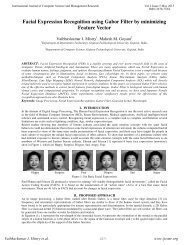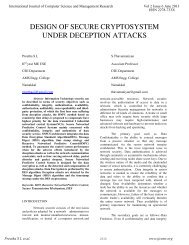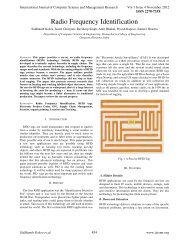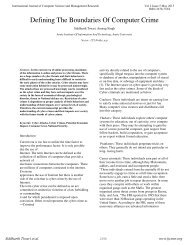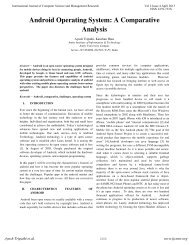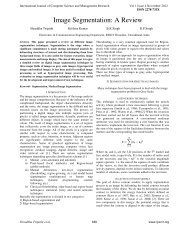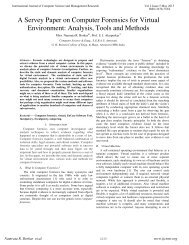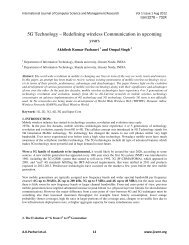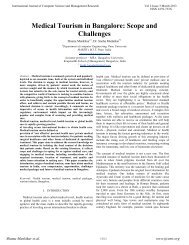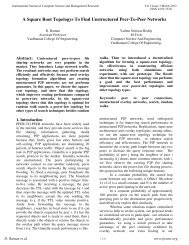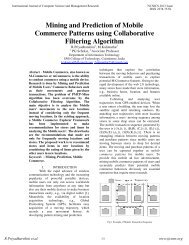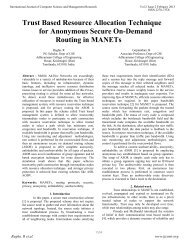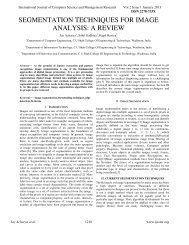A Survey on Seeded Region Growing based Segmentation ... - ijcsmr
A Survey on Seeded Region Growing based Segmentation ... - ijcsmr
A Survey on Seeded Region Growing based Segmentation ... - ijcsmr
You also want an ePaper? Increase the reach of your titles
YUMPU automatically turns print PDFs into web optimized ePapers that Google loves.
Internati<strong>on</strong>al Journal of Computer Science and Management Research Vol 2 Issue 6 June 2013<br />
ISSN 2278-733X<br />
A <str<strong>on</strong>g>Survey</str<strong>on</strong>g> <strong>on</strong> <strong>Seeded</strong> Regi<strong>on</strong> <strong>Growing</strong> <strong>based</strong><br />
Segmentati<strong>on</strong> Algorithms<br />
Savneet Dhaliwal #1 , Abhilasha Jain *2<br />
# Computer Science Engineering, Giani Zail Singh PTU Campus,<br />
Bathinda , Punjab , India<br />
1<br />
savneetdhaliwal12@gmail.com<br />
2<br />
abd_jain@rediffmail.com<br />
Abstract— This paper c<strong>on</strong>sists a survey <strong>on</strong> various seeded regi<strong>on</strong><br />
growing <strong>based</strong> segmentati<strong>on</strong> algorithms. In this survey we try to<br />
find out the problems in existing algorithm. The main goal is<br />
build a solid platform to automate the initial seed placement in<br />
regi<strong>on</strong> growing. Because random initial seed produces dependent<br />
regi<strong>on</strong>s <strong>based</strong> up<strong>on</strong> their positi<strong>on</strong>s. This paper also discusses the<br />
role of the segmentati<strong>on</strong> in visi<strong>on</strong> theory. Various seed placement<br />
segmentati<strong>on</strong> algorithms are c<strong>on</strong>sidered.<br />
Keywords— Segmentati<strong>on</strong> , Seed , Regi<strong>on</strong> split.<br />
I. INTRODUCTION<br />
The motivati<strong>on</strong> of this research is to provide an overview<br />
of the most recent trends and future research directi<strong>on</strong> in<br />
colour image segmentati<strong>on</strong>. Rather than covering all aspects<br />
of the domain this survey covers issues related to the most<br />
active areas in last few years. This survey gives an overview<br />
about the issues and problems of colour segmentati<strong>on</strong>. It<br />
focuses <strong>on</strong> the various techniques that are used for the image<br />
segmentati<strong>on</strong> with their success and weaknesses. It also<br />
prescribes the importance of image segmentati<strong>on</strong> in various<br />
fields of engineering and medical practices like computer<br />
visi<strong>on</strong>, medical imaging processes.<br />
Moreover image segmentati<strong>on</strong> can be viewed as the core<br />
branch for image processing as all the post coming work like<br />
feature extracti<strong>on</strong> and object recogniti<strong>on</strong> depends up<strong>on</strong> the<br />
quality of image segments produced. The main goal of image<br />
segmentati<strong>on</strong> is do- main independent partiti<strong>on</strong>ing of an image<br />
into a set of disjoint regi<strong>on</strong>s that are visually deferent,<br />
homogeneous and meaningful with respect to some<br />
characteristics or computed property such as grey level,<br />
texture or colour to enable easy image analysis. Image<br />
segmentati<strong>on</strong> is a useful tool in many realms including<br />
industry, health care, astr<strong>on</strong>omy, and various other _ends.<br />
Segmentati<strong>on</strong> in c<strong>on</strong>cept is a very simple idea.<br />
Simply looking at an image, <strong>on</strong>e can tell what regi<strong>on</strong>s are<br />
c<strong>on</strong>tained in a picture. Is it a building, a pers<strong>on</strong>, a cell, or just<br />
simply background Visually it is very easy to determine what<br />
a regi<strong>on</strong> of interest is and what is not. Doing so with a<br />
computer algorithm <strong>on</strong> the other hand is not so easy. How do<br />
you determine what dense a regi<strong>on</strong> What features distinguish<br />
<strong>on</strong>e regi<strong>on</strong> from another What determines how many regi<strong>on</strong>s<br />
you have in a given image Disc<strong>on</strong>tinuity and<br />
similarity/homogeneity are two basic properties of the pixels<br />
in relati<strong>on</strong> to their local neighbourhood used in many<br />
segmentati<strong>on</strong> methods.<br />
The segmentati<strong>on</strong> methods that are <strong>based</strong> <strong>on</strong> disc<strong>on</strong>tinuity<br />
property of pixels are c<strong>on</strong>sidered as boundary or edges <strong>based</strong><br />
techniques and that are <strong>based</strong> <strong>on</strong> similarity or homogeneity are<br />
regi<strong>on</strong> <strong>based</strong> techniques.<br />
II. IMAGE SEGMENTATION<br />
Image segmentati<strong>on</strong> is a process in which regi<strong>on</strong>s or<br />
features sharing similar characteristics are identified and<br />
grouped together. It is a process of extracting and representing<br />
informati<strong>on</strong> from an image by grouping pixels together into<br />
regi<strong>on</strong>s similarity. Most segmentati<strong>on</strong> techniques are either<br />
regi<strong>on</strong>-<strong>based</strong> or edge-<strong>based</strong>:<br />
A. Regi<strong>on</strong> Based Segmentati<strong>on</strong><br />
The regi<strong>on</strong> <strong>based</strong> segmentati<strong>on</strong> is partiti<strong>on</strong>ing of an image<br />
into similar/homogenous areas of c<strong>on</strong>nected pixels through<br />
the applicati<strong>on</strong> of homogeneity/similarity criteria am<strong>on</strong>g<br />
candidate sets of pixels. Each of the pixels in a regi<strong>on</strong> is<br />
similar with respect to some characteristics or computed<br />
property such as colour, intensity and/or texture. Regi<strong>on</strong> split<br />
and merge as well as Regi<strong>on</strong> growing are the points of interest<br />
in this domain.<br />
B. Edge Based Segmentati<strong>on</strong><br />
Edge <strong>based</strong> segmentati<strong>on</strong> is the locati<strong>on</strong> of pixels in the<br />
image that core- spend to the boundaries of the objects seen in<br />
the image. An edge or a linear feature is manifested as an<br />
abrupt change or disc<strong>on</strong>tinuity in digital number of pixels<br />
al<strong>on</strong>g a certain directi<strong>on</strong> in an image.<br />
Savneet Dhaliwal et.al.<br />
2814<br />
www.<strong>ijcsmr</strong>.org
Internati<strong>on</strong>al Journal of Computer Science and Management Research Vol 2 Issue 6 June 2013<br />
ISSN 2278-733X<br />
Figure 1: Segmentati<strong>on</strong> Techniques<br />
Determine the appropriate Stopping gradient or other<br />
stopping criteria is the point of interest.<br />
III. LITERATURE SURVEY<br />
In the Literature <str<strong>on</strong>g>Survey</str<strong>on</strong>g> part research work d<strong>on</strong>e by<br />
various researchers has been revisited to decide up<strong>on</strong> the<br />
problem domain in which to pursue my thesis. The research<br />
papers studied during the course work have been described<br />
below brie to summarize the crux of what has been studied.<br />
Deferent researchers have presented deferent analysis of<br />
image segmentati<strong>on</strong> techniques.<br />
Researcher [1] describe Colour image segmentati<strong>on</strong> refers<br />
to partiti<strong>on</strong>ing an image into deferent regi<strong>on</strong>s that are<br />
homogeneous with respect to some feature. Image<br />
segmentati<strong>on</strong> is usually the first task to any image Analysis<br />
process. All subsequent task like feature extracti<strong>on</strong> and object<br />
recogniti<strong>on</strong> depends up<strong>on</strong> the quality of image segmentati<strong>on</strong>.<br />
Over segmentati<strong>on</strong> an image will split an object into deferent<br />
regi<strong>on</strong>s while in under segmentati<strong>on</strong> it will group various<br />
objects into <strong>on</strong>e regi<strong>on</strong>.<br />
In this paper researchers tested [8] Image segmentati<strong>on</strong> in<br />
track light management system. It works in the manner like<br />
first an image is taken in a n<strong>on</strong>-track mode of a track z<strong>on</strong>e.<br />
Image is c<strong>on</strong>verted into gravy scale. Now deferent images are<br />
to be taken from the roads emerging towards track light.<br />
Again those images are c<strong>on</strong>verted into gravy scale. Deferent<br />
images are compared with image in n<strong>on</strong>-track mode and <strong>based</strong><br />
<strong>on</strong> the comparis<strong>on</strong> with intensity of light track management is<br />
d<strong>on</strong>e.<br />
In this paper researcher [7] proposed Image segmentati<strong>on</strong><br />
techniques and issues. In areas such as computer visi<strong>on</strong> and<br />
image processing, image segmentati<strong>on</strong> has been and still is a<br />
relevant research area due to its wide spread usage and<br />
applicati<strong>on</strong>. Its accuracy but very elusive is very crucial in<br />
areas as medical, remote sensing and image retrieval where it<br />
may c<strong>on</strong>tribute to save, sustain and protect human life. This<br />
paper provides a survey of achievements, problems being<br />
encountered, and the open issues in the research area of image<br />
segmentati<strong>on</strong> and usage of the techniques in deferent areas.<br />
In this survey we also suggested what must be d<strong>on</strong>e in<br />
order for researchers to test their techniques performance and<br />
to compare them am<strong>on</strong>g other segmentati<strong>on</strong> techniques.<br />
Researchers c<strong>on</strong>sidered the techniques under the following<br />
three groups i.e. Threshold Based, Edge Based and Regi<strong>on</strong><br />
Based.<br />
In this work [11] a new approach to fully automatic colour<br />
image segmentati<strong>on</strong>, called JSEG, is presented. First, colours<br />
in the image are quantized to several representing classes that<br />
can be used to differentiate regi<strong>on</strong>s in the image. Then, image<br />
pixel colours are replaced by their corresp<strong>on</strong>ding colour class<br />
labels, thus forming a class-map of the image.<br />
A criteri<strong>on</strong> for “good” segmentati<strong>on</strong> using this class-map<br />
is proposed applying the criteri<strong>on</strong> to local windows in the<br />
class-map results in the “J-image”, in which high and low<br />
values corresp<strong>on</strong>d to possible regi<strong>on</strong> boundaries and regi<strong>on</strong><br />
centres, respectively. A regi<strong>on</strong> growing method is then used to<br />
segment the image <strong>based</strong> <strong>on</strong> the multi-scale J-images.<br />
Experiments show that JSEG provides good segmentati<strong>on</strong><br />
results <strong>on</strong> a variety of images.<br />
In this paper, researcher [9] provide regi<strong>on</strong> <strong>based</strong><br />
segmentati<strong>on</strong> techniques categorize as:<br />
A. Regi<strong>on</strong> Split<br />
The basic idea of regi<strong>on</strong> splitting is to break the image into<br />
a set of disjoint regi<strong>on</strong>s, which are coherent within themselves:<br />
Initially take the image as a whole to be the area of interest.<br />
Look at the area of interest and decide if all pixels c<strong>on</strong>tained<br />
in the regi<strong>on</strong> satisfy some similarity c<strong>on</strong>straint, If TRUE then<br />
the area of interest corresp<strong>on</strong>ds to an entire regi<strong>on</strong> in the<br />
image. If FALSE split the area of interest (usually into four<br />
equal subareas) and c<strong>on</strong>sider each of the sub-areas as the area<br />
of interest in turn. This process c<strong>on</strong>tinues until no further<br />
splitting occurs. In the worst case this happens when the areas<br />
are just <strong>on</strong>e pixel in size. This is a divide and c<strong>on</strong>quer or top<br />
down method.<br />
B. Regi<strong>on</strong> Merge<br />
The result of regi<strong>on</strong> merging usually depends <strong>on</strong> the order<br />
in which regi<strong>on</strong>s are merged. The simplest methods begin<br />
merging by starting the segmentati<strong>on</strong> using regi<strong>on</strong>s of 2x2,<br />
4x4 or 8x8 pixels. Regi<strong>on</strong> descripti<strong>on</strong>s are then <strong>based</strong> <strong>on</strong> their<br />
statistical gravy level properties. A regi<strong>on</strong> descripti<strong>on</strong> is<br />
compared with the descripti<strong>on</strong> of an adjacent regi<strong>on</strong>; if they<br />
Savneet Dhaliwal et.al.<br />
2815<br />
www.<strong>ijcsmr</strong>.org
Internati<strong>on</strong>al Journal of Computer Science and Management Research Vol 2 Issue 6 June 2013<br />
ISSN 2278-733X<br />
match, they are merged into a larger regi<strong>on</strong> and a new regi<strong>on</strong><br />
descripti<strong>on</strong> is computed. Otherwise regi<strong>on</strong>s are marked as<br />
n<strong>on</strong>-matching. Merging of adjacent regi<strong>on</strong>s c<strong>on</strong>tinues between<br />
all neighbours, including newly formed <strong>on</strong>es. If a regi<strong>on</strong><br />
cannot be merged with any of its neighbours, it is marked `-<br />
nil' and the merging process stops when all image regi<strong>on</strong>s are<br />
so marked.<br />
In this paper [2] Active C<strong>on</strong>tour Method was proposed. An<br />
active c<strong>on</strong>tour is an energy minimizing spline that detects<br />
species features within an image. It is an edible curve (or<br />
surface) which can be dynamically adapted to required edges<br />
or objects in the image (it can be used to automatic objects<br />
segmentati<strong>on</strong>). It c<strong>on</strong>sists of a set of c<strong>on</strong>trol points c<strong>on</strong>nected<br />
by straight lines. The active c<strong>on</strong>tour is denned by the number<br />
of c<strong>on</strong>trol points as well as sequence of each other. Fitting<br />
active c<strong>on</strong>tours to shapes in images is an interactive process.<br />
The user must suggest an initial c<strong>on</strong>tour, which is quite close<br />
to the intended shape.<br />
The c<strong>on</strong>tour will then be attracted to features in the image<br />
extracted by internal energy creating an attractor image.<br />
Figure 2: Basic c<strong>on</strong>tour formati<strong>on</strong><br />
In paper [10] researchers has implemented Active<br />
c<strong>on</strong>tours, or snakes, have been used widely for image<br />
segment- stati<strong>on</strong>. A novel method incorporating geodesic<br />
curves and regi<strong>on</strong> informati<strong>on</strong> is introduced. The extra regi<strong>on</strong><br />
force gives the active c<strong>on</strong>tour model a global complementary<br />
view of the boundary informati<strong>on</strong> within the image. The<br />
proposed method incorporates edge informati<strong>on</strong>, namely<br />
Edgewood, into Active C<strong>on</strong>tours. We refer to this as<br />
Edgewood-driven Geometric Snake or EDGS. The partial<br />
differential equati<strong>on</strong> (PDE) resulting from this integrati<strong>on</strong> of<br />
image Edgewood and regi<strong>on</strong> term is implemented using a<br />
level set approach. Experimental results dem<strong>on</strong>strate that the<br />
proposed method makes sound results, especially with respect<br />
to images within weak boundaries, and noise.<br />
In this paper [6] researcher propose selecti<strong>on</strong> of seed<br />
points. Seed point selecti<strong>on</strong> is <strong>based</strong> <strong>on</strong> some user criteri<strong>on</strong>.<br />
The initial regi<strong>on</strong> begins as the exact locati<strong>on</strong> of these seeds.<br />
The regi<strong>on</strong>s are then grown from these seed points to adjacent<br />
points depending <strong>on</strong> a regi<strong>on</strong> membership criteri<strong>on</strong>. The<br />
criteri<strong>on</strong> could be, for example, pixel intensity, gravy level<br />
texture, or colour. Since the regi<strong>on</strong>s are grown <strong>on</strong> the basis of<br />
the criteri<strong>on</strong>, the image informati<strong>on</strong> itself is important. For<br />
example, if the criteri<strong>on</strong> were a pixel intensity threshold value,<br />
knowledge of the histogram of the image would be of use, as<br />
<strong>on</strong>e could use it to determine a suitable threshold value for the<br />
regi<strong>on</strong> membership criteri<strong>on</strong>.<br />
In this paper L et. al [5] Seed <strong>Growing</strong> method is<br />
discussed. Segmentati<strong>on</strong> of medical images using seeded<br />
regi<strong>on</strong> growing technique is increasingly becoming a popular<br />
method because of its ability to involve high-level knowledge<br />
of anatomical structures in seed selecti<strong>on</strong> process. Regi<strong>on</strong><br />
<strong>based</strong> segmentati<strong>on</strong> of medical images are widely used in<br />
varied clinical applicati<strong>on</strong>s like visualizati<strong>on</strong>, b<strong>on</strong>e detecti<strong>on</strong>,<br />
tumour detecti<strong>on</strong> and unsupervised image retrieval in clinical<br />
databases.<br />
As medical images are mostly fuzzy in nature, segmenting<br />
regi<strong>on</strong>s <strong>based</strong> intensity is the most challenging task. In this<br />
paper, authors has discussed about popular seeded regi<strong>on</strong><br />
grow methodology used for segmenting anatomical structures<br />
in images. Researchers have proposed a gradient <strong>based</strong><br />
homogeneity criteria to c<strong>on</strong>trol the regi<strong>on</strong> grow process while<br />
segmenting images. <strong>Seeded</strong> regi<strong>on</strong> growing approach to image<br />
segmentati<strong>on</strong> is to segment an image into regi<strong>on</strong>s with respect<br />
to a set of q seeds as presented in is discussed here. Given the<br />
set of seeds, S1, S2, Sq., each step of SRG involves<br />
identifying <strong>on</strong>e additi<strong>on</strong>al pixel to <strong>on</strong>e of the seed sets.<br />
Moreover, these initial seeds are further replaced by the<br />
centroids of these generated homogeneous 8 regi<strong>on</strong>s. The <strong>on</strong>ly<br />
drawback of SRG algorithm is the docility in automating seed<br />
generati<strong>on</strong> and dependency of output <strong>on</strong> order sorting of pixel<br />
as deferent order of processing pixels during regi<strong>on</strong> grow<br />
process leads to deferent final segmentati<strong>on</strong> results.<br />
In this paper researcher [4] proposed that Segmentati<strong>on</strong> of<br />
ultrasound images is a midcult task, due to numerous artefacts<br />
and the presence of speckled noise. Dentiti<strong>on</strong>s between<br />
objects are often blurred and weakened by speckling.<br />
C<strong>on</strong>sequently, segmentati<strong>on</strong> methods for ultrasound must be<br />
resistant to noise. In this paper, a method called <strong>Seeded</strong><br />
Regi<strong>on</strong> <strong>Growing</strong> (SRG) is tested in isolating regi<strong>on</strong>s of<br />
interest for later processing.<br />
The SRG method involves selecting points called seeds as<br />
the starting locati<strong>on</strong>s for the segmentati<strong>on</strong> process. Seed<br />
points may be manually or automatically selected, and both<br />
methods of seed selecti<strong>on</strong> are tested and compared. The<br />
Savneet Dhaliwal et.al.<br />
2816<br />
www.<strong>ijcsmr</strong>.org
Internati<strong>on</strong>al Journal of Computer Science and Management Research Vol 2 Issue 6 June 2013<br />
ISSN 2278-733X<br />
resulting system is tested <strong>on</strong> simulated objects and B-mode<br />
ultrasound images of the liver with suspected lesi<strong>on</strong>s.<br />
IV. HOW SEEDED REGION GROWING WORKS<br />
Figure 3 is dem<strong>on</strong>strate that how seeded regi<strong>on</strong> growing<br />
will work to grow pixel by pixel to achieve the segmentati<strong>on</strong>.<br />
Figure 3: Seed growing Method<br />
C<strong>on</strong>clusi<strong>on</strong>s<br />
By doing a deep survey <strong>on</strong> high quality journal we have found<br />
that the placing a seed in seeded regi<strong>on</strong> growing segmentati<strong>on</strong><br />
algorithm is a critical issue. Wr<strong>on</strong>gly selected seed not give<br />
much accurate results. This paper has also shown the various<br />
algorithms which can be applied to segment a given image<br />
using regi<strong>on</strong> growing <strong>based</strong> algorithms. This paper has also<br />
shown the working of seed placement algorithms. In near<br />
future new algorithm will be proposed which will<br />
automatically select the seed to segment given image in<br />
efficient manner.<br />
REFERENCES<br />
[1] K<strong>on</strong>stantinos N. Plataniotis Alain Tremeau, Shoji Tominaga, “Color in<br />
image and video processing: Most recent trends and future research<br />
directi<strong>on</strong>s”, pages 1-26, 2008.<br />
[2] Marian Bakos, “Active c<strong>on</strong>tours and their utilizati<strong>on</strong> at image<br />
segmentati<strong>on</strong>”, pages 17-21, 2007.<br />
[3] David Boen, “<strong>Seeded</strong> regi<strong>on</strong> growing”, 2004.<br />
[4] David Boen, “Segmenting 2d ultrasound images using seeded regi<strong>on</strong><br />
growing”, 2006.<br />
[5] T.R.Gopalakrishnan Nair Harikrishna Rai G.N. Gradient <strong>based</strong> seeded<br />
regi<strong>on</strong> grow method for ct angiographic image segmentati<strong>on</strong>. 2011.<br />
[6] R.K.Krishna2 Shilpa Kamdi1. Image segmentati<strong>on</strong> and regi<strong>on</strong> growing<br />
algorithm. pages 103-107.<br />
[7] Sunday O.Ojo Tranos Zuva, Oludayo O. Olugbara and Seleman M.<br />
Ngwira. Image segmentati<strong>on</strong>, available techniques, developments and<br />
open issues. pages 20-29, 3, March 2011.<br />
[8] Kshitij Pawar & S.S Rathod Vikramaditya Dangi, Amol Parab. Image<br />
processing <strong>based</strong> intelligent traffic c<strong>on</strong>troller. pages 13-17, 2012.<br />
[9] Yu-Hsiang Wang. Image segmentati<strong>on</strong>. January, 2010.<br />
[10] XIN GAO 2 YING YANG 1, 2. Image segmentati<strong>on</strong> using edgeowdriven<br />
geometric snake. pages 505-509, 2007.<br />
[11] B.S.Manjunath Yining Deng and Hyundoo Shin. Halft<strong>on</strong>e visual<br />
cryptography. Trans.Img.Proc., August 2006.<br />
Savneet Dhaliwal et.al.<br />
2817<br />
www.<strong>ijcsmr</strong>.org




